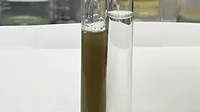Water Treatment in Outer Space
International Space Station crews soon will have a new water reclamation system
that will recycle wastewater, allowing up to six crew members to live aboard
the orbiting laboratory.
“Recycling will be an essential part of daily life for future astronauts, whether on board the space station or living on the moon,” says Mike Suffredini, the station program manager. “Delivering this hardware is an important step in achieving the station’s full potential, allowing for additional crew members and more scientific research.” By recycling, the system reduces the dependence on Earth resupply by cutting the amount of water and consumables needed to be launched by about 15,000 pounds a year.
As early as the late 1960s, we knew sustaining life in space would require recycling water and oxygen,” notes project manager Bob Bagdigian. “A number of us have experienced the entire lifecycle of this technology, all the way from early ideas to implementation. Knowing that we will see this system completed gives us great pride.”
Through a series of chemical treatment processes and filters, the water recovery system creates water clean enough to drink. In fact, part of the same process has been used in Third World countries to produce drinkable water. A distillation process is used to recover water from urine and sweat. The process occurs within a rotating distillation assembly that compensates for the absence of gravity, aiding in the separation of liquids and gases in space. Once distilled, the water from the urine processor is combined with other wastewaters and delivered to the water processor for treatment. The water processor removes free gas and solid materials, such as hair and lint, before the water goes through a series of filtration beds for further purification. Any remaining organic contaminants and microorganisms are removed by a high-temperature catalytic reaction. These rigorous treatment processes create water that meets stringent purity standards for human consumption.
“Recycling will be an essential part of daily life for future astronauts, whether on board the space station or living on the moon,” says Mike Suffredini, the station program manager. “Delivering this hardware is an important step in achieving the station’s full potential, allowing for additional crew members and more scientific research.” By recycling, the system reduces the dependence on Earth resupply by cutting the amount of water and consumables needed to be launched by about 15,000 pounds a year.
As early as the late 1960s, we knew sustaining life in space would require recycling water and oxygen,” notes project manager Bob Bagdigian. “A number of us have experienced the entire lifecycle of this technology, all the way from early ideas to implementation. Knowing that we will see this system completed gives us great pride.”
Through a series of chemical treatment processes and filters, the water recovery system creates water clean enough to drink. In fact, part of the same process has been used in Third World countries to produce drinkable water. A distillation process is used to recover water from urine and sweat. The process occurs within a rotating distillation assembly that compensates for the absence of gravity, aiding in the separation of liquids and gases in space. Once distilled, the water from the urine processor is combined with other wastewaters and delivered to the water processor for treatment. The water processor removes free gas and solid materials, such as hair and lint, before the water goes through a series of filtration beds for further purification. Any remaining organic contaminants and microorganisms are removed by a high-temperature catalytic reaction. These rigorous treatment processes create water that meets stringent purity standards for human consumption.
Looking for a reprint of this article?
From high-res PDFs to custom plaques, order your copy today!




